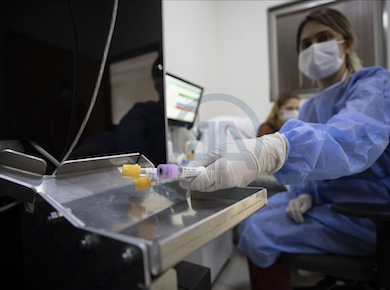It is an excerpt from the Ministry of Health website1.
SBU Izmir Tepecik Training and Research Hospital Central Sample and Blood Collection Unit receives an average of 1000 applications per day. Before the arrangement, each patient had to enter the regsitration and sample tube preparation queue, and then the blood taking queue. After registration for the first application to the unit, the sample containers and tubes were given to the person who would give the sample. In this way, the applicant was again in line, this time to have blood drawn or to give samples. Since there was no numbering system and no prioritization option according to the general condition of the patient, patients were exposed to long waiting times regardless of their general condition and age. It is known that there is a relationship between the waiting time of the individuals who give blood in the blood collection unit, their anxiety levels and the pain felt during the procedure. In addition, the fact that the patient waits at different stages in the blood collection unit in an empty state, mostly standing, reduces patient satisfaction considerably. However, beyond the satisfaction-reducing effect of these waits, there are also negative reflections on some test results. For example, prolonging the 8-12 hour fasting period may actually cause the high glucose level to enter the normal value range. Fasting, prolonged waiting time, phlebotomy being an invasive procedure, etc. Increased stress due to factors such as adrenocorticotropic hormone (ACTH), cortisol, dehydroepiandrosterone, prolactin, and thyroid stimulating hormone may cause false elevations, leading to incorrect diagnosis and treatment. It has been reported that postural changes caused by standing up due to unwanted queues in high volume blood collection units have negative effects on biochemical tests. Prolongation of test request result times should be prevented, causing delays in diagnosis and treatment, and adversely affecting patient safety.
In accordance with regulations such as Quality Standards in Health and Medical Laboratory Regulation; It is necessary to provide regulations such as the type of sample required for sampling, preliminary information, if any, rules for sampling, sample transfer conditions and time to give results, reduce sample rejection or even completely reset it. For this reason, thanks to the system giving all the instructions about what to do and when to all resources (human or machine) involved in the process starting with the doctor's test request from the patient in the blood collection process, and the follow-up and coordination of the given works automatically by the system. Errors in the current process have been eliminated. For patient and sample safety, the patient's contact with the sample container and samples is prevented. Again, by creating a standardized system in the blood collection unit, both patient satisfaction is increased and delays in diagnosis and treatment are prevented by reducing the sample rejections that may occur in the form of incorrect labeling, sampling from the wrong patient, incorrect sample tube collection and improperly taken sample.
The sampling process has become transparent and traceable, as the system can provide information on when and by whom the sample was taken, and monitoring the performance of the phlebotomist/nurse who took the sample. One of the important advantages of the system is that it determines the number of phlebotomists/nurses that will be needed in the unit, based on the number of patients who will come to the sampling unit from the outpatient clinic, thanks to the artificial intelligence infrastructure it contains.

It is still used in our Blood and Sampling Unit, which serves under the joint responsibility of Medical Biochemistry and Medical Microbiology Laboratories.
The application started on October 11, 2017 and is still being implemented in our hospital's Center and Bornova Oncology Sample and Blood Collection Units.
The purpose of the application was to eliminate long queues in blood collection units and problems during sampling. The hardware need for efficient and effective use of the system has been determined. Two 40'' screens were placed in the waiting room so that the patients could monitor the voice call system. In line with the Ministry of Health circular, 3 kiosk devices were placed at the entrance gates, allowing patients to enter the blood collection system and to welcome patients, allowing priority patients to be included in the out-of-queue system.
Errors in the current process, thanks to the fact that the system gives all instructions on what to do and when to do all the resources (human or machine) involved in the process that starts with the doctor's test request from the patient, and the follow-up and coordination of the given works is provided automatically by the system has been eliminated. For patient and sample safety, the patient's contact with the sample container and samples is prevented. Again, by establishing a standardized system in the blood collection unit, both patient satisfaction is increased and delays in diagnosis and treatment are prevented by reducing the sample rejections that may occur in the form of incorrect labeling, sampling from the wrong patient, incorrect sample tube collection and improperly taken samples.Excerpt from Original Article1

After the above-mentioned work, with an additional study, the labeling robot NESLI was successfully applied in Tepecik EAH Bornova Annex Building.
In this study, tubes are selected and labeled by robots without manual intervention, and when the patient reaches the nurse's desk, they are presented directly to the nurse by the robot.
Thus, the labor required for labeling was saved. In addition, patient-staff contact is minimized, as there is no need for a secretary in the hall for labeling. Thus, it has contributed to the safer continuation of the functions of the unit under Covid-19 conditions.
Youtube link of this additional application: https://www.youtube.com/watch?v=IaXI9gJ8vrM&t=17s
1https://iyiuygulamaornekleri.saglik.gov.tr/TR,82856/numune-ve-kan-alma-birimi-isleyisinin-yapay-zeka-destekli-otomatizasyon.html
A project done at SBU Tepecik EAH, based on Phlerobo system, has been selected amongst the best practices list of Ministry of Health.
When using pre-barcoded tubes, mostly blood collection units with high sample counts are considered ...